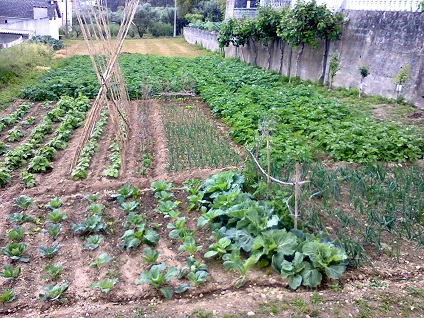
Outdoor gardens
Anyone can, and should, plant a garden.
In outdoor environments there are several choices to plants all kinds of plants. there´s pots, flowerbeds, small areas within a garden or any big or small areas without use.
Generally all the plants mention for the indoor environments can be moved to the exterior, moved directly to the soil for a definitive localion or just for a production cycle.
To be successful it is important to respoect the individual needs of each plant, regarding sunlight exposure, type of soil, irrigation and climate. It is advisable to follow closely the plants development in order to identify any indication that the plants are not developing properly and make some changes until you reach the perfect planting conditions.
It is important to understand that all places have their unique qualities so your success will depend on a trial and error aproach.
Here are some of the plants that can be grown in pots, flowerbeds or directly in the soil, in outdoor environments, and some general information required to plant them.
Sunlight; Irrigation; Soil; Other information; Planting calendar; Harvest; Crop rotation; Crop association; Edible uses.
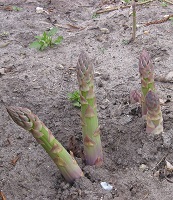
It can be in a place with full sun exposure or in partial shaded areas, the most important is to have good sunlight.
The irrigation should be abundant but avoiding the excess water in the soil.
Prefers sandy and loose soils so it is important to add some organic matter after the planting.
It does not develop in pots as it needs some space. So the planting space as to be definitive and well thought. It is advisable to get young plants as the use of seeds is a longer process until you get any production. At the end of the harvest and at the end of the Winter it is necessary to cut the plants a few centimeters of the ground so they can grow back again.
The planting should be done in March. It is done through rhizomes that once in the ground will last several years. The planting should be done in lines with enough space for the harvest. It is also important to cover the soil, the most common is to use straws, to control the growing of weeds and to keep the soil moist.
The harvest should be done in May for a short period of time and very carefully with the trampling near the plants.
Does not apply
Does not apply
Asparagus are very appreciated in culinary and they mainly used in rice dishes and as garnish. The edible part is the shoots so it is advisable to bend them until they naturally brake separating the tender part from the tough one, which is not edible.
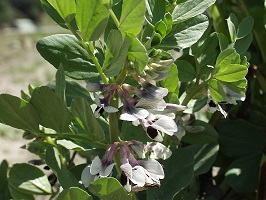
Does not like full sun exposure prefering half shaded areas.
Irrigation should be controlled as it is important for the flowering and fructification.
It is not demanding but prefers well drained and clay soils.
This is one of the plants that are important as it has the capacity to fix nytrogen emproving the quality of the soil. So it is important, at the end of the production cycle, to cut the plant at the base leaving only its root on the ground.
The planting should be done in the end of the Winter until the beginning of the Spring, and it is important to keep the ground free of weeds that could compete with the plants so it is advisable to cover it with straws.
The harvest should be done at the beginning of Summer and when they are tender.
The crop rotation should be done every two or three years.
It does well when planted close to artichokes but it should not be planted close to garlic, leeks or onions.
It is commonly used in stews but also in salads.

It is not demanding in terms of sunlight, however the sunlight exposure should not be intense.
Irrigation should be regular and frequent.
Prefers a neutral and well drained soil.
It is an autumn/winter crop that can go until spring and does not like high temperatures.It can handle well with low temperatures, intense cold and winter frost.
The sowing should be done in a greenhouse or in some place with good sunlight exposure and with mild temperatures. The young plants should be moved for a definitive location in Spring. The plants should have 40 centimetres between each other and the soil should be covered with straw or other kind of material to keep the moisture.
The harvest is done in late autumn, winter and early spring. It is a slow growth crop but is one of the plants that lasts long because as its being harvested new shoots start to grow.
The crop rotation should be done every three years.
It does well when planted near potatoes or onions.
The better way to use in culinary is to steam it maintaining all its properties.

It requires full sun exposure and needs to be protected from the wind.
Irrigation should be regular and abundant, mostly during fructification, altough it can handle a couple of days without water. It is able to recover from a period with no water.
Needs a rich soil and well ventilated. Adding compost is beneficial to its development.
It is advisable to get some seeds or young plants that are already adapted to the planting location. The spicy varieties should not be planted near the sweet ones as they can all become spicy at the time of pollination. The different varienties are identified through their color, size, shape and form, and all of them have a exquisite taste.
The sowing should be done in small containers and the young plants should be moved to its definitive location in the Spring as soon as there are no risk of frost.
The harvest should be done in the Summer approximately two months after the sowing when it comes to green peppers. The red peppers just need to change color to be harvested.
The crop rotation should be made every three or four years.
It does well when planted near eggplants, tomatos and leguminous plants.
It can be used raw, in salads and chilled soups, or in meat, fish or seafood stews. It can also be used dried and grounded to use in marinades.

Does not like full sun exposure nor high temperatures.
Irrigation should be regular but in small amounts at a time.
Requires a deep and sandy soil.
It can handle the frosts as long as the roots are fully developed. Does not need a much compost and it benefits from the aditional wood ashes as its nutritional needs are phosphorus and potassium. There are several varieties so it is possible to choose the ones that can do better to the weather conditions of a given location so you can have a constant production throughout the year.
The sowing can be done all year depending on the climate.
The harvest should be done after two months of the sowing but they can be left in the ground as long as the temperatures aren´t too high.
The crop rotation is important and should be done every four or five years.
They can benefit from being close to other cultures as onions or leeks as they work as a natural repellent for the carrot fly (Psila rosae).
It is used both raw and cooked in a great variety of dishes and salads. It is also commonly used and very appreciated in juices.

The sunlight exposure should be soft as it does not like full sun nor excess shading.
Irrigation should be abundant and regular so the soil is permanently moist.
It needs a loose soil and it is important to fertilize through its development. The addition of good compost to the soil will benefit this crop.
The different varieties can be identified through the color but generally can be considered two kinds, summer and winter cauliflowers.
The sowing should be done in between May and July, in a greenhouse or in a protected place. The moving of the new plants should be done gradually so the production can be as long as possible.
The harvest start after two months of the sowing.
This plant is very demanding for the soil so it is important to promote crop rotation.
Cauliflower does well when planted close to onions, potatos, spinach and other varieties of its family.
It can be used as a main ingredient or as garnish. Some popular uses are for example cauliflower purée or cauliflower gratin.

It grows better with full sun exposure at least for couple of hours a day but it does well also in parcial shade. In warmer climates it is more likely to get better results if planted in cooler places with parcial shade or avoiding full sun exposure in the hotter hours of the day.
Irrigation must be constant in order to maintain the soil moist, without excess water in the soil. It suffers a lot with drought and as soon as it happens the plant enters in stress mode.
Prefers moist soils, without excess water, well drained and deep in order for the roots to have vertical growth.
Likes cool temperatures and as soon as it gets fully developed it can handle well with frosts.
The seeds can take some time to germinate so they should be put on the ground and covered with a thin layer of soil. Once the young plants have 5 to 6 leaves they should me moved to their definitive location, in the beginning of Spring. The plants should have 20 to 25 centimeters between each other.
The leaves can be collected gradually allowing the plant to develop throughout the season.
The crop rotation should be done every two or three years.
To prevent the attack of aphids, also known as plant lice or blackflies, greenflies and whiteflies, plant it next to lettuce and leek as they make a good association all together.
It is most commonly used to flavour several cooked dishes as it is a very fragrant herb.

Needs full sun exposure as it likes the heat both in the environment and in the soil.
Irrrigation should be frequent and regular as the lack of water can cause its development stoppage. However it should not occur any soaking to avoid a temperature drop.
It requires a rich, well drained, loose and deep soil.
It is one of the plants that improves the quality of the soil due to its capacity to fix atmospheric nytrogen. There are two kinds of common bean plants, creepers and climbers. The creepers don´t need tutors and have a shorter cycle of life so they are more appropriate to small areas or flowerbeds.
The planting should be done at the end of Spring or beginning of Summer. It should be done directly in the soil and in trenches. Sow two or three seeds per hole spaced 35 to 40 centimeters between each other.
The harvest can start in the Summer and go on throught the season.
The crop rotation should be done every three years.
It does well when planted near cucumbers, carouts, cabbage and capsicums. However it should not be planted near garlic, onions and leeks.
They can be used in several dishes but the most common use is in meat or fish stews.
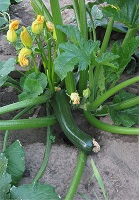
Needs full sun exposure, heat and a protected area. It is a more suitable crop to be developed in a greenhouse.
Irrigation should regular but not excessive and it is not recommended to pour water over the plant. Instead you should just keep the soil moist.
It needs a rich soil, deep and well drained that can keep the moist. It is a very demanding crop regarding the organic matter needs.
There are two kinds of zuchini plants, creepers and climbers. There so you can choose which kind fit better to your available planting space. The creepers need a covered soil, the most common is to use straws, to avoid the growing of weeds and also to keep the soil moist. The climbers require tutors, something that as they develop help them with its vertical growth.
The sowing should be done in March and April and the new plants should be moved to the soil, flowerbeds or pots in the beginning of May.
The harvest should be done when the fruits are tender avoiding the development of excess seeds.
The crop rotation should be done every two years.
They do well when planted close to cucumbers, cabbage and pumpkins.
In culinary it is most commonly used in soups and vegetable stews.

It needs and it is important to have full sun exposure.
The most advisable is to use dripping lines to avoid getting the plant wet. Irrigation should be frequent and abundant as soon as it starts flowering.
It requires a well drained soil as it is sensitive to excess moisture e can lead to the appearance of fungus. At the same time the soil has to keep moist.
As the fruits are being harvested it produces more and more.
The sowing can be done directly in the soil, in the beginning of the Summer, but it can also be done in small containers indoors and then move the young plants to its definitive location at the end of Spring. It is important to cover the ground with straws to have a moist soil , no weeds and that the fruits won´t touch the soil and be compromised.
The harvest should be done at the end of the Summer before the fruits get too mature and so with excess seeds.
The crop rotation should be done every three years.
It does well when planted close to courgette, cabbage, spinach and onions. It should not be planted near tomatos.
It is most commonly used raw, in saldas and chilled soups.

It requires a lot of sunlight, mild temperatures e and benefits of some humidity.
Irrigation must be regular and abundant as it is important for the fructification.
Requires a rich and moist soil. Whether you plant it in the soil or in pots or in any kind of containers it is important to keep adding compost continuously.
It is an annual culture, however it can be grown in places where there is no chance of frost. It is advisable to do some pruning in the winter so it sprouts again in spring. The pruning during its development favors the formation and growing of the fruits.
The sowing should be done in a greenhouse or in some place with good sunlight exposure and with mild temperatures. At the end of winter or beginning of spring you can move the young plants to its definitive location.
The harvest should be done before it reaches its maximum size avoiding the development of too many seeds and also from becoming bitter.
The crop rotation should be done every three years.
It does not benefit too much from the proximity to other cultures, however it does well near potatoes. On the contrary it should not be planted near tomatoes or peppers.
In culinary eggplants are usually combined with other vegetables. They are only used cooked both fried or grilled or even stuffed with meat.
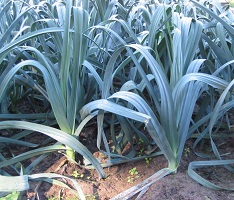
It is important good sun exposure because it likes the sunlight, however it can grow well also in the shade.
Irrigation must be constant in order to maintain the soil moist throughout the growing.
Prefers soils rich in organic matter, well drained and deep.
When it is well developed it does not suffer much with cold temperatures and frost.
The sowing, can be done at any time of the year, however it is ideal to do it in February and move th young plants to its definitive location in March. The young plants should be well buried deep in the soil.
The harvest should be done after approximately five months on the ground.
The crop rotation should be done every four to five years.
It does well when planted close to carrots, as they help each other to keep away the parasites, and also garlic and strawberries.
It can be used raw, but only the white part of the plant, in salads. But it is most commonly used in soups and stews as it is very fragrant.

It likes full sun exposure but it also does well in partial shade.
Irrigation is important so it needs to be regular and should avoid any dry periods that can be hurmful for the plant.
Requires a soil that can keep moist and that won´t retain the excess water.
Choosing the right varieties for the location climate conditions It is possible to achieve a constant production throughout the year. The sowing should be done every 15 days so you can harvest whenever it is needed.
The sowing should be done at the beginning of the Spring or at the end of the Summer. Should be done outdoors when the temperatures are not too cold, and then the young plants should be moved to its definitive location previously irrigated.
The harvest should be done, approximately, 90 days after the plants were moved. It will depend on the size and look of the plants.
Crop rotation is not important but it can be done every year.
It does well close to almost any plants.
It is most commonly used raw in salads, but it can also be used in soups or as a garnish.

The sunlight is important so it needs as much exposure as possible and needs protection from stronger winds.
Irrigation should be regular so the soil remains constantly wet, as long as the soil drains well. In the last days of growth the irrigation should be reduced so the onions won´t rot.
Requires a sandy soil but not acid. Before the sowing it needs to be added compost.
It is advisable to do a ground cover but it is not imperative as this crop can adapt easily to all kinds of soils, climates and calendars. Before the harvest you should bend the stalks by the middle without breaking them so the onions can grow bigger.
The sowing should be done in a sheltered place, for the Summer varieties, at the end of the season and the young plants should be moved to the definitive location at the middle of the Winter. For the Winter varieties the sowing should be done in a sheltered place at the end of the season and the young plants should be moved to the definitive location at the Spring.
The harvest should be done after three months of the planting. After the harvest it is important that they are left to dry outdoors or even in the sun so they won´t rot when they are stored.
The crop rotation should be done every three or four years.
It does well when planted near carrots, cucumbers, cauliflower and potatos. However it does not like to be close to beans and broad beans.
It is often used in culinary but mostly raw in salads and in the base of most dishes. It can also be used in soups and in several other ways.

It can have full sun exposure or not, as it can adapt to any kind of climate or conditions.
Irrigation should be regular but not in large amounts at the beginning.
It is not particularly demanding in terms of soil but does not deal well with tight and rocky soils as they affect the root growth. So it needs a soft and ventilated soil for a perfect root development.
There are several varieties of potato that differ in color, shape, texture and flavour so you should choose the ones you like the best and that will adapt better to the climate. This way you can plan annually according with the planting area you have, in order to get potatoes for the longest period possible.
The sowing should be done in Spring with potatos that were left in the soon until they sprout. After that they can be planted hole or in pieces until the roots grow 20 centímeters. At that time they need to be covered as they grow so the fruits won´t get any sunlight. It can also be cultivated in big containers in the following way, fill it with a 30 centimetres layer of compost and bury the seed, the potato. As the plant develops keep adding compost to force its vertical growth, both for the top of the plant as its roots. As soon as the vegetable matter dries you will have a considerable production from just a few seeds.
The harvest can go from the middle of the Summer to the Autumn depending on the kind of potatos.
The crop rotation should be done every three or four years.
It benefits of being planted near all kinds of bean plants but it does not do well when planted near tomato plants.
In culinary is an important ingredient as it can be used in all kinds of ways.
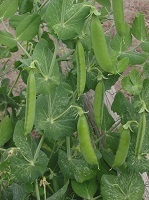
Does not require too much sunlight. It does well also in the shade.
The irrigation should be regular and frequent so the soil is constantly moist but not with excess water.
Requires a rich soil with a big amount of organic matter.
Likes the wet season and mild temperatures so it is one of the first vegetables of the season. Depending of the variety of it can be planted in the Winter to harvest in the Spring, or planted in Spring to harvest after two months before the warm weather. There are two kinds of pea plants, creepers and climbers. As in other plants it needs a covered soil, the most common is the use of straws, to avoid the growing of weeds and to keep the soil moist. The climbers require tutors, something that as they develop help them with its vertical growth. This is one of the plants that improve the structure of the soil by enrich it with nitrogen.
The sowing should be done directly in the soil, flowerbed or pot burying five or six seeds per hole spaced 35 to 40 centimeters between each other.
The harvest should be done as soon as the peas are tender and before they harden. Ideally they should be harvested every three days.
The crop rotation should be done every two or three years.
It does not do well only when planted close to garlic and onions.
It can be used in culinary as a main ingredient, as it is an exquisite food, or as a garnish.

Prefers areas with good sunlight exposure.
Irrigation should be abundant and constant. Does not tolerate drought.
The soil should be light, well drained and that can keep moist.
There are several kinds with different sizes, shapes and colors. They can also be considered according to the planting season, Summer and Winter.
The sowing should be done in covered place at the end of Spring and then move the young plants to a definitive location in the Summer, with a distance of one meter between plants in order for them to have enough space to develop.
The harvest should be done after six months of the planting.
The crop rotation should be done at least every two years.
There is no problem with associating it with other cultures however the ideal is to leave them isolated as it was mentioned previously it requires space for its good development.
In culinary it is used both the fruit and the flower. It is most commonly used in soups and stews but it can also be used in desserts.

Sunlight exposure is important for its development however it can handle reasonably cold temperatures.
Irrigation should be regular to avoid that the soil gets dry. The dripping lines are the most adequate.
It is not a demanding plant so it does well in almost every kind of soil.
Due to its fast growth it has a high nitrogen concentration so it is not advisable an excessive consumption.
It can be planted at any time of the year. It is a sensitive crop so the sowing should be superficial and without any ground cover.
The harvest can be one in less than a month after the planting.
Since it is not a demanding plant the crop rotation is not important.
It does well when planted near carrots, artichokes, kales, cucumbers, spinach and broad beans.
It is most commonly used raw in saladas and also in sauces. Also its leaves can be used as any other greens.
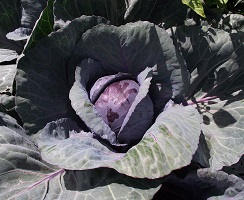
It can adapt to any kind of sunlight exposure, as long as it has wind protection.
It is not very demanding in terms of the irrigation but it should be regular in order to ensure a certain level of humidity in the soil.
It can adapt to any kind of soil as long as it is deep.
Depending on the pH level its leaves can be more or less pink, if it is an acid soil, or can be more or less blue, if it is an alkaline soil. The different kinds of red cabbage vary mainly in size and leaf texture.
The sowing directy on the soil should be done in Spring leaving enough space between plants for their proper growing.
The harvest can take as long as four months as its development can be slow but depending on the conditions the production may occur sooner for instance after only two months.
The crop rotation should be done every two years.
It does well when planted near potatos, cucumbers and lettuces. However it should not be planted near strawberries and broad beans.
It can be used raw, as long as it is tender, in salads but it is also used in soups.

Does not require full sun exposure, it prefers shade. It is better with cool and wet climates.
Irrigation should be regular but not in large amounts.
It needs a soil that retais the moisture so it can be constantly soaked. It needs some fertilizing with organic matter if not don´t do it as it can easily concentrate nytrogen.
It is not a hard crop but it advisable to avoid drought and heat as it can easily bloom and become toxic.
The soing should be done in between the months of March and May. So you can have a longer and constant production the sowing should be phased.
The harvest should be done after fourty five days of the sowing and the outer leaves should be picked first so the inner leaves can continue growing.
The crop rotation should be done every three years.
They do well when planted close to broad beans, brocolli, lettuce, beans and cauliflower.
When used raw in salads it keeps all its properties. But it can also be used in all kinds of dishes such as soups, pies or croquettes.

It develops better with full sun exposure however they handle better with cold temperatures than with heat. But overall it is a plant that can adapt easily to any kind of climate.
Irrigation should be abundant in order to maintain the soil constantly moist around the plant.
Prefers loose and acidic soils and it can benefit with the addiction of a good amount of compost.
It is better to start with young plants and from that you can multiply them very easily by burying the side shoots without separate them from the main plant until they root. They have a production cycle of aproximately three years so after that they need to be replaced.
The planting should be done in the beggining of Spring. It can be planted directly on the ground or in any kind of container. The containers have the advantage of avoiding that the fruits touch the soil and rot more easily. When planted directly on the ground it needs a straw cover to keep the soil moist and to keep the fruits dry and avoiding any contact with the soil.
The harvest usually can start in April and throughout the Summer.
The crop rotation should be done at least every three years.
It does well when planted near garlic and should not be planted close to cabbages.
It is most commonly used in all kind of desserts.

It requires full sun exposure, as much as possible.
Irrigation should be regular and abundant so the dripping lines are the most suitable.
Prefers well drained, ventilated and loose soils but it can adapt to any kind of soil. It is a demanding plant so it benefits with the addition of organic matter. The most advisable is a mixture of compost and manure,
There are numerous kinds of tomato that vary in flavour, color, size and shape.
For better results the use of young plants is a good option or do the sowing in a greenhouse proceeding with the moving of the new plants to the definitive location only when there is no risk of frosts. It can be planted in between the months of March and October. It is important to garantee the irrigation during the flowering and fructification in order to get a good production. The plants should be planted with 50 centímeters between each other.
The harvest should be done after two months, when they are mature and with a red color.
As it is a demanding plant the crop rotation should be done every three or four years.
It does well when planted near garlic, onions and leeks however it does not like to be close to eggplants and peppers.
It is a very versatile and used food. Used raw in salads, or in all kind of dishes used in sauces and stews. Or even in other ways such as dried,grilled, stuffed.